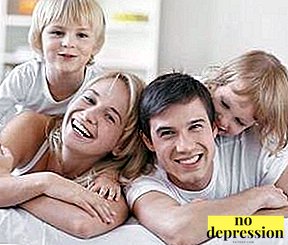During the whole life the child actively grows, develops personal and behavioral qualities.
Sometimes even the most cute and educated kid suddenly shows aggressive behavior, which baffles parents and others.
It is important to understand what caused such behavior, whether it is a one-time manifestation or a consequence of mental disorders.
Basic concepts

In terms of psychology, aggression are actions that are aimed at causing physical and mental pain to other people.
Autoagression is a behavior in which a child consciously or unconsciously hurts himself.
Every child at least once in his life showed aggression towards other people. The first signs appear even in infancy, the baby can pinch, bite, scratch.
After a year, aggression begins at the moment when the child wants to get something, but is forbidden to him. If with the help of aggressive behavior he achieves his goal, then a causal link is clearly fixed in his mind: aggression - goal achievement.
In the case when such actions are not stopped by the parents, aggression becomes a character trait and the main way to get what you want.
Aggressive behavior is expressed in the following ways:
- expression. These are facial expressions, gestures, poses. This form is the most difficult to diagnose;
- verbal version. Children swear, insult peers, are obscenely expressed;
- physical manifestation: fights, beatings and other physical effects.

Autoagression, or autodestruction has more serious reasons.
Psychoanalysts attribute it to the methods of psychological protection. Autodestruction may be verbal and physical.
In the first case, the child scolds himself, stops eating, he himself becomes a corner. During physical auto-aggression, the child inflicts physical injuries: it beats its head against the wall, scratches itself, and at a later age shows suicide attempts.
Self-destruction it occurs much less frequently than ordinary aggression; boys with neurotic behavior disorder are susceptible to it. This pathology is manifested in the conditions of social maladjustment.
The child can not resist stronger people, external stimuli, is afraid to destroy the relationship, therefore, redirects aggression from an external object to himself. This is a kind of psychological defense.
Autoagression can manifest itself in different forms:
- Self injury. Children cut themselves with a knife, beat their heads against the wall, disfigure their appearance.
- Pathological eating behavior. It is peculiar to schoolchildren, manifested in the rejection of food, water or the use of low-quality products that cause indigestion.
- Addiction from drugs, alcohol, cigarettes.
- Manifestations of autism. The child becomes self-contained, consciously does not communicate with peers and parents.
- Attempted suicide. This is the most severe manifestation of auto-aggression. The desire for suicide can be direct and indirect, when a teenager is engaged in extreme sport, provokes life-threatening situations.
The reasons

Why is the child aggressive?
The pathogenesis of both conditions consists in an imbalance between excitation and inhibition in the brain due to underdevelopment of certain brain structures.
After the ingress of the stimulus, the processes of inhibition turn on late.
Despite the difference in the manifestation of aggression and auto-aggression, the causes of this behavior are almost identical. They are physiological and psychological. Physiological include:
- serious diseases of the nervous system or heart;
- head injuries;
- brain tumor;
- transferred neuroinfections;
- birth trauma.
The main psychological cause of aggression and auto-aggression is social disadaptation. Usually it arises due to an unfavorable psychological climate in the family.
Provoking factorsand the emergence of pathological behavior are:
- Fear of physical punishment. The kid is not able to reflect the aggression of adults, so he throws out emotions on peers or on himself.
- Family conflicts. Children constantly observe swearing, quarrels in the family, especially accompanied by physical violence, they have a desire to protect the offended. But because of their age they cannot do this.
- The desire to attract the attention of parents. With the help of destructive behavior, children draw the attention of parents to themselves.
- Inflated claims. The kid does not meet the expectations of teachers and parents, he has a feeling of guilt.
- Heredity. If the parents refuse to eat, they close in the room, then the child will do the same.
- Features of the psyche. Usually, destructive behavior is manifested by shy children who do not know how to build relationships with peers who have too mobile mentality.

In small children up to a year the cause of aggression becomes improper weaning. The baby no longer feels protected by her mother, tries to regain her closeness and attention.
Older children (2–3 years of age) are trying with the help of destructive behavior. get what you want, for example, a toy, sweets. At the age of 4-5 years, the child usually begins to attend kindergarten, he develops social interaction skills.
If he has not learned to communicate with children before, he will demand attention to himself with the help of aggression. Such behavior is characteristic of the only children who are spoiled by their parents.
At 6-7 years old, the desire to become a leader in the class becomes the cause of destructive behavior. assert themselves. In adolescents, hormonal alteration becomes the cause of aggression and autoaggression.
Hidden aggression
One of the options for aggressive behavior is hidden, or passive aggression. In contrast to the explicit, it is expressed not in action, but in inaction. For example, refusal to communicate with parents, do homework, touchiness, etc.
Such children become skilled manipulators. They successfully hide their intentions, but by all means achieve their goals.
For example, a child does not want to go to school and complains of pains in the stomach, head, high fever. Sometimes he consciously can twist the leg, cut the finger, etc.
Detect hidden aggression can be on the following grounds:
- Lies. If you analyze the story of the child, you can find many inconsistencies.
- Distraction. The manipulator tries to take the victim aside in order to achieve his goal.
- Attempts to cause guilt. For example, a teenager complains to his parents that no one is friends with him, because he has an outdated phone or cheap sneakers.
- Putting the blame on others. Children constantly justify their aggressive behavior by provoking someone else to do so.
- Demonstration of innocence. The manipulator claims that any of his bad deeds is an accident, he didn’t want anything bad and didn’t expect it to happen.

What to do?
How to behave parents? At the first signs of aggression, one should be aware of what caused this behavior. Maybe baby just Mom's lack of attention.
First you need to adjust the psychological climate in the family. Children should not see parents quarrels, listen to screams and obscene expressions.
The second step is increased attention to the child. You need to talk to him, find out what disturbs him, what he is afraid of. Parents should explain that they love their son or daughter and are able to protect him from all problems.
A prerequisite is a single line of behavior for both parents. It is impossible for one to forbid everything and the other to allow everything.
Parents are also required spend as much free time with your child, go on nature, go to cafes, entertainment centers and by their behavior set an example of social interaction.
How to react and suppress anger?

How to remove an attack of aggression from a child? Anger easier to prevent than to pay off.
Parents know the behavior of the baby, so it is easy to notice the oncoming signs of destructive behavior.
You can cope with the situation using the following methods:
- Distraction. At the first signs of aggression, the child’s attention should be shifted to another object or activity.
- Condemnation of behavior. You cannot encourage or ignore outbursts of anger. Parents should explain that this is bad, offer to eliminate the consequences of such behavior: remove toys, feel sorry for the offended.
- Promotion. Be sure to praise the kid for good deeds.
- Offer alternatives. This refers to verbal aggression. Sometimes a child does not know how to express his emotions in a different way. Parents should tell you how to replace bad words.
A great way to re-educate an overly aggressive child is to write it into the sports section. In the classroom he will be taught discipline, there he will throw out extra emotions.
Psychology tips
There are some psychological tricks that help to cope with aggression:
- smashing pillows;
- expression of emotions through drawing;
- relaxation exercises;
- performing physical exercises that require considerable effort, for example, jumping, somersaults;
- singing songs in a loud voice.

Great importance has good nutrition, the regime of the day of the child.
It should protect the son or daughter from watching aggressive films, computer games, especially before bedtime.
At night you can read a calm good book, talk about something pleasant.
Parental mistakes
In a relationship with aggressive children, parents make a series of mistakes:
- blackmail, threats;
- physical punishment;
- ignoring destructive behavior;
- encouraging aggression;
- translation of the situation into a joke.
It is often easier for adults to yield to a little tyrant and give him what he requires than to cope with his antics.
This is the biggest mistake. The child is formed a clear belief that to achieve the goal is only possible with the help of destructive actions, screams, physical violence or manipulation.
Also wrong defend and justify the behavior of his offspring before offended by other children, to shift the blame on the victim.
Point of View Komarovsky

The famous doctor Komarovsky believes that in no case aggression cannot be ignored.
In some cases, the child should respond the same. This does not mean that the child should be beaten in response.
He just has to realize that his behavior is not encouraged. When aggression is manifested, parents should do the following:
- Stop the baby. For example, hold his hand, close his mouth with his hand, firmly say that it is impossible to do so.
- Suggest steam on inanimate objects, that is, knock with a stick on the ground, stomp with your feet, shout loudly.
- Correctly state the child in words.: "You are angry, you are offended, you are upset."
- After the baby calmed down, have a quiet conversation about the causes of behavior, explain that emotions need to be expressed in other ways.
Treatment
Sometimes aggression and autoaggression are not amenable to correction. educational measures. In these cases, resort to the help of doctors.
Therapy will be effective with an integrated approach and a combination of different techniques.
The following methods are used for the treatment of pathology:
- Family Psychotherapy. The doctor conducts sessions with parents. The main focus is on the conversation, discussion of family conflicts. They teach parents and children to express emotions and solve problems peacefully, master practical ways of expressing aggression: outdoor games, singing, drawings.
- Cognitive psychotherapy. The psychotherapist in an individual conversation reveals the negative personal attitudes of the child: low self-esteem, fear, unnecessary responsibility, fear of punishment.
- Trainings in the group. Usually used for school-aged aunts. They are taught to interact, resolve conflicts, build social ties. Positive emotions from other participants positively affect the child, increase its importance and self-esteem.
- Medication treatment. It is used in extreme cases when outbreaks of aggression and auto-aggression become dangerous for the child and others. Antidepressants, antipsychotics and sleeping pills are usually prescribed.

Destructive behavior among children is quite common.
The main reason is difficult psychological situation in the family.
If parents do not pay attention to the pathological manifestations, then aggression and auto-aggression will turn into character traits that will create many problems in adulthood.
If psychotherapeutic techniques are powerless, resort to drug therapy.
How to deal with child aggression aimed at others, how to fight child aggression? Psychologist tips:



